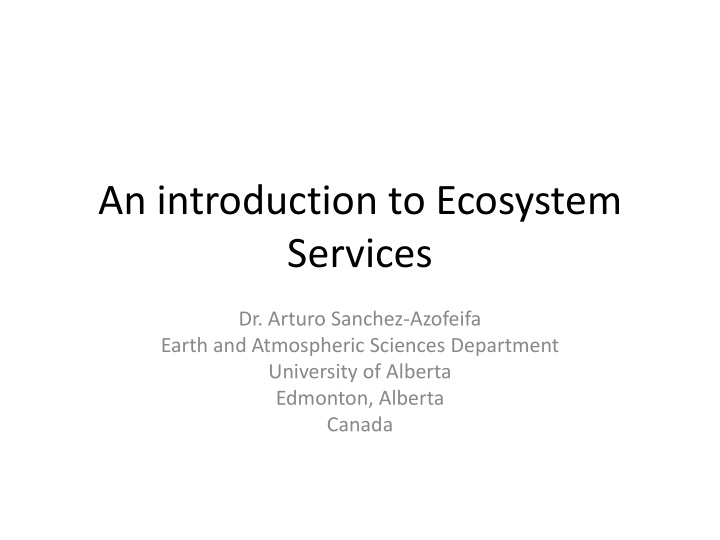



An introduction to Ecosystem Services Dr. Arturo Sanchez-Azofeifa Earth and Atmospheric Sciences Department University of Alberta Edmonton, Alberta Canada
Unprecedented change in structure and function of ecosystems More land was converted to cropland in the 30 years after 1950 than in the 150 years between 1700 and 1850. Cultivated Systems in 2000 cover 25% of Earth ’ s terrestrial surface (Defined as areas where at least 30% of the landscape is in croplands, shifting cultivation, confined livestock production, or freshwater aquaculture)
Unprecedented change: Ecosystems 20% of the world ’ s coral reefs were lost and 20% degraded in the last several decades 35% of mangrove area has been lost in the last several decades Amount of water in reservoirs quadrupled since 1960 Withdrawals from rivers and lakes doubled since 1960 Intercepted Continental Runoff: 3-6 times as much water in reservoirs as in natural rivers (Data from a subset of large reservoirs totaling ~65% of the global total storage)
Unprecedented change: Ecosystems 5-10% of the area of five biomes was converted between 1950 and 1990 More than two thirds of the area of two biomes and more than half of the area of four others had been converted by 1990
Unprecedented change: Biogeochemical Cycles Since 1960: Flows of biologically available nitrogen in terrestrial ecosystems doubled Flows of phosphorus tripled > 50% of all the synthetic nitrogen fertilizer ever used has been used since 1985 60% of the increase in the atmospheric concentration of CO 2 since 1750 has taken place since 1959 Human-produced Reactive Nitrogen Humans produce as much biologically available N as all natural pathways and this may grow a further 65% by 2050
Some ecosystem recovery now underway but high rates of conversion continue Ecosystems in some regions are returning to conditions similar to their pre-conversion states Rates of ecosystem conversion remain high or are increasing for specific ecosystems and regions
Changes to ecosystems have provided substantial benefits Food production has more than doubled since 1960 Food production per capita has grown Food price has fallen
Ecosystem Services • Tangible: – Biodiversity – Water – Soil conservation • Untangible – Carbon sequestration – Weather regulation
Defining Ecosystems and Ecosystem Services Ecosystems are the combined interactions of: Biological / living (plant, animal and micro-organism communities ) components of environment and Physical / non-living components (air, water, soil and the basic elements and compounds of the environment) 9 Courtesy of US Forest Service
Air quality Pest & disease control Wild species & habitat protection Carbon sequestration & storage Soil formation & fertility Plant pollination Watershed protection & regulation Courtesy of US Forest Service 10
Ecosystem Services & the Economy Product Inputs 1. Environmental Goods food, freshwater, fuel, fiber Production Process Inputs 2. Regulating Services Stable Business Operating climate regulation, flood regulation, Context water filtration Healthy worker 3. Supporting Services fundamentals (e.g., clean nutrient cycling, soil formation air, adequate amounts of 4. Cultural Services water, food, etc.) aesthetic, spiritual, educational, recreational Contributors to ‘license to 11 operate’ Courtesy of US Forest Service
Focus: Ecosystem Services The benefits people obtain from ecosystems
The Three Challenges of Ecosystem Service Valuation 1. Ecology: quantities/qualities of ecosystem services 2. Economics: values of ecosystem services 3. Linking ecology and economics Courtesy of Stephen Polasky
Challenge 1: Ecology What is the ecological production function? ( quantity/quality of services) From ecosystem structure and function To ecosystem services - do we know how services are produced? - do we know how production changes as ecosystem is altered? Courtesy of Stephen Polasky
Challenge 2: Economics What are the values of services? From quantities (quality) To values - what methods can be applied to ascertain values? - are these methods reliable? - total values or marginal values? Courtesy of Stephen Polasky
Challenge 3: Linking ecology and economics • Production function (ecology) • Valuation (economics) Often studies by one group do not mesh with studies by other group Studies of ecologists and economists need to link together to get estimates of value of ecosystem services Courtesy of Stephen Polasky
Examples Organized examples by increasing scale/complexity – Value of a single service in an ecosystem – Multiple services within an ecosystem – Comprehensive services measures Courtesy of Stephen Polasky
So … what are we going to learn in this PDS • Different perspectives on measuring ecosystem services. • Econometric aspects to quantify those services. • Learn about advanced monitoring techniques for ecosystem services in dry forests.
Recommend
More recommend